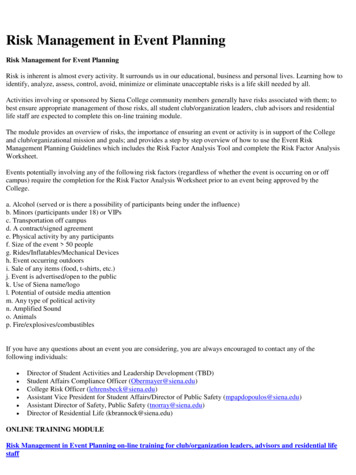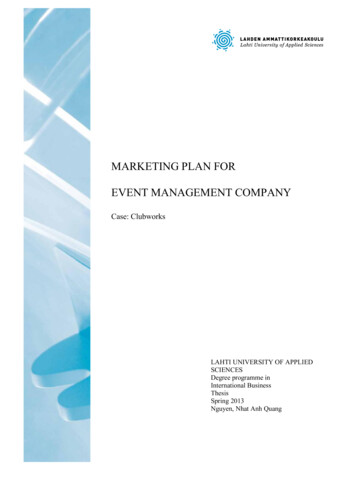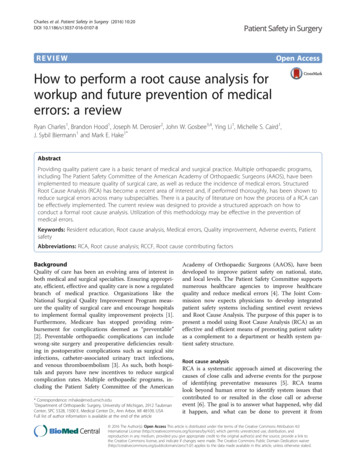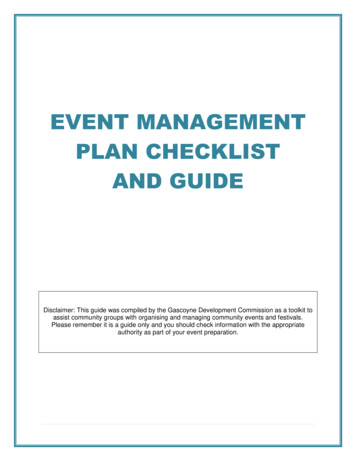
Transcription
Risk Management in Event PlanningRisk Management for Event PlanningRisk is inherent is almost every activity. It surrounds us in our educational, business and personal lives. Learning how toidentify, analyze, assess, control, avoid, minimize or eliminate unacceptable risks is a life skill needed by all.Activities involving or sponsored by Siena College community members generally have risks associated with them; tobest ensure appropriate management of those risks, all student club/organization leaders, club advisors and residentiallife staff are expected to complete this on-line training module.The module provides an overview of risks, the importance of ensuring an event or activity is in support of the Collegeand club/organizational mission and goals; and provides a step by step overview of how to use the Event RiskManagement Planning Guidelines which includes the Risk Factor Analysis Tool and complete the Risk Factor AnalysisWorksheet.Events potentially involving any of the following risk factors (regardless of whether the event is occurring on or offcampus) require the completion for the Risk Factor Analysis Worksheet prior to an event being approved by theCollege.a. Alcohol (served or is there a possibility of participants being under the influence)b. Minors (participants under 18) or VIPsc. Transportation off campusd. A contract/signed agreemente. Physical activity by any participantsf. Size of the event 50 peopleg. Rides/Inflatables/Mechanical Devicesh. Event occurring outdoorsi. Sale of any items (food, t-shirts, etc.)j. Event is advertised/open to the publick. Use of Siena name/logol. Potential of outside media attentionm. Any type of political activityn. Amplified Soundo. Animalsp. Fire/explosives/combustiblesIf you have any questions about an event you are considering, you are always encouraged to contact any of thefollowing individuals: Director of Student Activities and Leadership Development (TBD)Student Affairs Compliance Officer (Obermayer@siena.edu)College Risk Officer (lehrensbeck@siena.edu)Assistant Vice President for Student Affairs/Director of Public Safety (mpapdopoulos@siena.edu)Assistant Director of Safety, Public Safety (tnorray@siena.edu)Director of Residential Life (kbrannock@siena.edu)ONLINE TRAINING MODULERisk Management in Event Planning on-line training for club/organization leaders, advisors and residential lifestaff
DOCUMENTS/FORMSEvent Risk Management Planning Guidelines (includes directions for completing the Risk Factor AnalysisWorksheet)Risk Factor Analysis Tool (this form must be completed for any event potentially involving any of the following riskfactors (regardless of whether the event is occurring on or off campus) require the completion for the Risk FactorAnalysis Worksheet prior to an event being approved by the College.) A completed copy of the form must be signed bythe director of Student Activities and Leadership Development or designee/supervisor or advisor) and a copy must beprovided to the Student Affairs Risk Officer.Risk Factorsa. Alcohol (served or is there a possibility of participants being under the influence)b. Minors (participants under 18) or VIPsc. Transportation off campusd. A contract/signed agreemente. Physical activity by any participantsf. Size of the event 50 peopleg. Rides/Inflatables/Mechanical Devicesh. Event occurring outdoorsi. Sale of any items (food, t-shirts, etc.)j. Event is advertised/open to the publick. Use of Siena name/logol. Potential of outside media attentionm. Any type of political activityn. Amplified Soundo. Animalsp. Fire/explosives/combustiblesSiena College - 515 Loudon Road, Loudonville, NY 122111-888-AT-SIENA (1-888-287-4362) Contact Us
One University DriveORANGE, CA 92866(714) 997-6815 2014 Chapman University6. Risk ManagementIt is important to be mindful of safety and security needs when planning an event.To begin the risk management process, review the Activity Risk chart in the Activity Risk Assessment Manual to seea representative sampling of various types of activities and their risk levels. Review the low, medium, high or extrahigh criteria to determine the minimum requirements associated with your plans.**This list is not all inclusive of the various risks that you may encounter. If your activity is not represented on thechart, contact Risk Management to identify requirements for your event.Complete the Risk Assessment Questionnaire in the Activity Risk Assessment Manual. Recognized studentorganizations should submit this form to the Department of Student & Campus Life for initial review.Risk Management will work with event planners to answer risk management questions and ensure all necessaryprecautions are taken to minimize risk at your event, including confirmation of adequate activity/event insurancecoverage or facilitation of appropriate liability.Note: If your event includes more than one activity, your assessment must be based on the one single activity thatbears the highest level of risk.Click below for the following resources:Risk Management Resource MaterialsWaiver FormsActivity Risk Assessment FormCertificate of Insurance Request FormSpecial Events Insurance - TULIP ProgramGlossary of Insurance TermsCOI: Indemnity and Insurance RequirementsInsurance and Certificate of Insurance TrainingInternational Travel Medical Assistance Enrollment Form
How to Develop a Risk Management PlanEdited by Kene, Krystle, Cipher nemo, Jonathan E. and 26 others"Denial is a common tactic that substitutes deliberateignorance for thoughtful planning."Developing an effective Risk Management Plan is an important part of any project,but unfortunately, is often viewed as something that can be dealt with later. Issues often do comeup though and without a well developed plan, even small issues can become emergencies. Thereare different types of Risk Management and different uses that include calculating creditworthiness, determining how long the warranty on a product should last and calculating insurancerates. In this document, we will look at Risk Management from the standpoint of planning foradverse events.Charles TremperAdSteps1.
1Understand how Risk Management works. Risk is the effect (positive or negative) of an event or series of events that take place in one orseveral locations. It is computed from the probability of the event becoming an issue and the impact it would have (See Risk Probability XImpact). Various factors should be identified in order to analyze risk, including: Event: What could happen? Probability: How likely is it to happen?
Impact: How bad will it be if it happens? Mitigation: How can you reduce the Probability (and by how much)? Contingency: How can you reduce the Impact (and by how much)? Reduction Mitigation X Contingency Exposure Risk – Reduction After you identify the above, the result will be what’s called Exposure. This is the amount of risk you simply can’t avoid.Exposure may also be referred to as Threat, Liability or Severity, but they pretty much mean the same thing. It will be usedto help determine if the planned activity should take place. This is often a simple cost vs. benefits formula. You might use these elements to determine if the risk of implementing thechange is higher or lower than the risk of not implementing the change. Assumed Risk. If you decide to proceed (sometimes there is no choice, e.g. federally mandated changes) then your Exposurebecomes what is known as Assumed Risk. In some environments, Assumed Risk is reduced to a dollar value which is then used tocalculate the profitability of the end product.Ad2.
2Define your project. In this article, let's pretend you are responsible for a computer system that provides important (but not life-critical)information to some large population. The main computer on which this system resides is old and needs to be replaced. Your task is to developa Risk Management Plan for the migration. This will be a simplified model where Risk and Impact are listed as High, Medium or Low (that isvery common especially in Project Management).
3.3Get input from others. Brainstorm on risks. Get several people together that are familiar with the project and ask for input on what couldhappen, how to help prevent it, and what to do if it does happen. Take a lot of notes! You will use the output of this very important sessionseveral times during the following steps. Try to keep an open mind about ideas. "Out of the box" thinking is good, but do keep control of thesession. It needs to stay focused and on target.
4.4Identify the consequences of each risk. From your brainstorming session, you gathered information about what would happen if risksmaterialized. Associate each risk with the consequences arrived at during that session. Be as specific as possible with each one. "ProjectDelay" is not as desirable as "Project will be delayed by 13 days." If there is a dollar value, list it; just saying "Over Budget" is too general.
5.5Eliminate irrelevant issues. If you’re moving, for example, a car dealership’s computer system, then threats such as nuclear war, plaguepandemic or killer asteroids are pretty much things that will disrupt the project. There’s nothing you can do to plan for them or to lessen theimpact. You might keep them in mind, but don’t put that kind of thing on your risk plan.
6.6List all identified risk elements. You don’t need to put them in any order just yet. Just list them one-by-one.
7.7Assign probability. For each risk element on your list, determine if the likelihood of it actually materializing is High, Medium or Low. If youabsolutely have to use numbers, then figure Probability on a scale from 0.00 to 1.00. 0.01 to 0.33 Low, 0.34 to 0.66 Medium, 0.67 to 1.00 High. Note: If the probability of an event occurring is zero, then it will be removed from consideration. There’s no reason to considerthings that simply cannot happen (enraged T-Rex eats the computer).
8.8Assign impact. In general, assign Impact as High, Medium or Low based on some pre-established guidelines. If you absolutely have to usenumbers, then figure Impact on a scale from 0.00 to 1.00 as follows: 0.01 to 0.33 Low, 0.34 – 066 Medium, 0.67 – 1.00 High. Note: If the impact of an event is zero, it should not be listed. There’s no reason to consider things that are irrelevant, regardless ofthe probability (my dog ate dinner).
9.9Determine risk for the element. Often, a table is used for this. If you have used the Low, Medium and High values for Probability andImpact, the top table is most useful. If you have used numeric values, you will need to consider a bit more complex rating system similar to thesecond table here. It is important to note that there is no universal formula for combining Probability and Impact; that will vary betweenpeople and projects. This is only an example (albeit a real-life one): Be flexible in analysis. Sometimes it may be appropriate to switch back and forth between the L-M-H designations and numericdesignations. You might use a table similar to the one below.
10.10Rank the risks: List all the elements you have identified from the highest risk to the lowest risk.
11.11Compute the total risk: Here is where numbers will help you. In Table 6, you have 7 risks assigned as H, H, M, M, M, L, and L. This cantranslate to 0.8, 0.8, 0.5, 0.5, 0.5, 0.2 and 0.2, from Table 5. The average of the total risk is then 0.5 and this translates to Medium.
12.12Develop mitigation strategies. Mitigation is designed to reduce the probability that a risk will materialize. Normally you will only do this forHigh and Medium elements. You might want to mitigate low risk items, but certainly address the other ones first. For example, if one of yourrisk elements is that there could be a delay in delivery of critical parts, you might mitigate the risk by ordering early in the project.
13.13Develop contingency plans. Contingency is designed to reduce the impact if a risk does materialize. Again, you will usually only developcontingencies for High and Medium elements. For example, if the critical parts you need do not arrive on time, you might have to use old,existing parts while you’re waiting for the new ones.
14.14Analyze the effectiveness of strategies. How much have you reduced the Probability and Impact? Evaluate your Contingency and Mitigationstrategies and reassign Effective Ratings to your risks.
15.15Compute your effective risk. Now your 7 risks are M, M, M, L, L, L and L, which translate to 0.5, 0.5, 0.5, 0.2, 0.2, 0.2 and 0.2. This givesan average risk of 0.329. Looking at Table 5, we see that the overall risk is now categorized as Low. Originally the Risk was Medium (0.5).After management strategies have been added, your Exposure is Low (0.329). That means you have achieved a 34.2% reduction in Riskthrough Mitigation and Contingency. Not bad!
16.16Monitor your risks. Now that you know what your risks are, you need to determine how you’ll know if they materialize so you’ll know whenand if you should put your contingencies in place. This is done by identifying Risk Cues. Do this for each one of your High and Medium riskelements. Then, as your project progresses, you will be able to determine if a risk element has become an issue. If you don’t know these cues,it is very possible a risk could silently materialize and affect the project, even if you have good contingencies in ment-Plan
Risk Management Plan for EventsAn event is full of uncertainties like power failure, equipment failure, medical emergency, brawl, stampede, fire, sponsorship withdrawal, lastminute turned down by an artist etc. How will you deal with all these contingencies without a well thought out risk management plan.Risk management is done at each and every stage of event production. For e.g. when risk management is done in the information managementfield, then it deals with loss of data due to data theft or hard disk crash. When risk management is done in the security management field, then itdeals with brawl, stampede, medical emergency, accidental fire etc.Similarly there are risks associated with: human resource, finance, marketing, quality management, attendees, food and beveragesmanagement, programs, technical management, infrastructure, logistic, procurement and team management.Developing Risk Management Plan for EventsSince risk management is a very important part of event management therefore it should be carried out in a planned and professional manner.Following steps are involved in risk management:Step 1: Identify those elements or activities which could carry a risk.A list of such elements is already specified above like information management, security, procurement etc.Step 2: Identify the risks associated with each element or activity.For e.g. cargo theft is associated with logistic management. Similarly, data loss is associated with information management.Step 3: Determine the possibility of occurrence of the risk and the severity of the consequences if the risk does happen. For e.g.ElementsRiskPossibilitySeverityInformation ManagementLoss of dataLowVery highData theftHighHighData CorruptionVery highVery highBrawlLowLowSecurity ManagementStep 4: Risk PrioritizationRisks with high severity of the consequences should be handled first.Step 5: Formulate, prepare and implement strategies to manage risks.Some common strategies used for risk management are:*Risk AvoidanceAvoid those elements and activities which could carry a risk.*Risk RetentionAccept some or all the consequences associated with a particular risk.*Risk TransferTransfer the risk to a third party. For e.g. transferring the event security responsibility to a security agency.*Risk ReductionReduce the risk associated with a particular element or activity by developing an effective contingency action plan.Step 6: Monitor the risks periodicallyso that the strategies used to manage the risks can be updated or ment-events.php
Managing Special Event RisksBy Joe Risser and Melanie Lockwood HermanNote: This article is excerpted from a forthcoming publication from the Nonprofit Risk Management Center: Managing Special Event Risks: 10 Steps to Safety—2ndEdition. The book will be available for purchase in September. For more information, or to-pre-order a copy, click here.Summer is here! Like predictable summer storms, high temps and visiting relatives, nonprofits from coast to coast are planning and presenting a wide range ofspecial events. With our children home from school, workaholics taking much needed time off, and the stress of poor economic conditions affecting everything wedo, many nonprofits are moving forward with special events as a way to raise awareness about vital causes and raise funds to cover some of the costs of servicedelivery.Well-planned and executed special events can bring positive publicity, new donors and an infusion of cash to a nonprofit. But events that don’t integrate sound riskmanagement can spell disaster for both the mission and the future of a nonprofit.In Managing Special Event Risks we discuss “ten steps to safety” as a way of providing practical guidance on the planning and staging of a special event. The stepsgive a framework for the planners to follow to prevent and manage risk as well as finance losses associated with special events. This article explores the first two ofthese vital “steps.”STEP 1—Establish GoalsThe first step in the development of a special events risk management program is to identify the organization’s purpose in creating and sponsoring the event andto ensure that:the purpose and execution of the special event advance the mission of the organization. This can happen by providing service to the community (e.g. a blooddrive), increasing awareness of the organization and its goals, raising funds for the achievement of those goals or a combination of these purposes.the special event and its activities are mission-appropriate. If something goes wrong at your event, the media coverage and community response to the eventshould not be “What were they thinking?”the organization has the resources and the skills to create and manage the special event. TIP: failure to plan planning to fail.Once you have established the overall purpose and goals of the special event and have confirmed that it will advance the nonprofit’s mission and is missionappropriate, you should identify event specific risk management goals. These may include:Prevent injury—including injuries to staff, spectators, participants and others—in the activity and ensure rapid, effective and appropriate response to any injury.Operate legally and in compliance with agreements with facility owners and service providers.Reduce the cost of insurance and avoid jeopardizing eligibility for insurance coverage.Meet financial goals—for many nonprofits a key goal of special events is to generate net income that can be used for mission fulfillment.Avoid event cancellation—for example, an event planned by a nonprofit may be key to sustaining interest in a particular cause. Canceling the event could bedisastrous to an ongoing advocacy effort or cause unnecessary ill will among stakeholders.Fulfill social responsibilities—risk management is sometimes perceived as part of a nonprofit’s responsibility in offering programs which meet community needs.Reduce anxiety about risk—many nonprofits look at sound risk management practices as one way to manage the anxiety about mishaps that may be expressed bydedicated staff, board members and community members.
By determining your risk management objectives before undertaking a special event, you can guide the process of planning and managing the event to increasethe odds of success on many levels.STEP 2—Organize to Manage the Special Event and Assign Key FunctionsPeople are the key to success for most nonprofit programs, including special events. Organizing a team is a big step to ensure a successful event. Irrespective ofhow a team is organized, it is important to remember that each member of the group should view themselves as a team member.The organizational structure used successfully for emergency response operations provides a simple and responsive functional model for a special eventsmanagement team:Special Event DirectorOverall leadership, responsibility, direction and control of the special eventPublic Information—MediaLiaison—communication & coordination with representatives from other entitiesSafety for entire event, all operationsOperations CoordinatorServices and activities involving attendees and participantsFood, beverages, seating, lighting, communicationsSanitation, trash, restroomsSafety CoordinatorRisk management, emergency response, evacuation, rain or rescheduling/relocation planning and coordinationIncident and status reports during event, post-event evaluationLogistics CoordinatorContracting with vendors providing supplies and servicesCoordinating services for event staff and volunteersFinance CoordinatorRegistrations, sales and donationsInsurance claims reporting and coordinationFor a small event or activity all five functions can be managed by a person or two. For larger events, each of the primaryfunctions should be assigned to a member of the special event management team. As a special event increases in size and complexity, additional people should beassigned specific tasks.Creating a special events management team has the benefit of focusing on the planning and management of the special event and establishing who is specificallyresponsible for each function. Important information regarding the planning or management of the event can be handled by the team. This can be critical inemergency situations that require decisive action.This structure is referred to as the “Incident Command System.” More information is available on this topic.
While some large nonprofits have a fulltime risk manager, most small to mid-sized agencies use a team approach to identify and control risks in their day to dayoperations and special events. This approach has advantages when people from different units become advocates for safety. The likelihood of spotting hazardsincreases when more than one person is involved in the effort.Managing special event risks requires equal measures of awareness, planning, diligence and team work. The time spent on this aspect of your special event iscertain to contribute to the event’s success and the favorable reputation your nonprofit enjoys in the community it es/rmbasics060709.shtml
Risk management tips for nonprofit event planningWhen planning an auction, community festival, performance, dinner or other type of nonprofit fundraising event, it's important to be as prepared as possible. Inaddition to coordinating all the components that make up an event, such as invitations, food service and entertainment, it's essential to prepare for potential just-incase scenarios.In addition to having the right donation management software and fundraising management technology to secure transactions, it's important to take otherprecautionary measures to ensure the event is a success.The NonProfit Times highlights several scenarios that should be considered when planning a fundraising event. They include:A keynote speaker cancelationEvent location staff strike or boycottA vital event planner abandons the project or cannot attend the eventA natural disaster occursSecurity issues arise with guestsWhile it may not be likely that any of these potentially dangerous situations occur, if one does, the organization hosting the event risks putting donations, dedicatedfollowers, staff devotion, safety and credibility on the line.Six just-in-case stepsSometimes, risky situations are unavoidable. However, a well-prepared nonprofit can guarantee it has the tools to react quickly and eliminate or reduce the effectsof certain happenings. EventEducation.com, a resource provider for event planners, outlines the steps hosts should take to mitigate risks:1.Identify potential risks: It's important to make a list of all negative scenarios that could occur at the event. Decision-makers should consider risks withinthe following departments: human resources, finances, marketing, attendance, food and beverage service, technology, infrastructure and eventscheduling.2.Determine consequences: Why are these scenarios risky? Write out the short- and long-term effects of each situation. For example, a small fire couldimmediately jeopardize attendees' safety and compromise the organization's reputation in future.3.Weigh the possibility of each event occurring: Looking at the root cause of each risk will help decision-makers better formulate back-up plans. Forexample, by measuring the likelihood of something negative occurring, nonprofits can decide whether to hire more security professionals or store backupequipment nearby.4.Prioritize risk mitigation: After determining the likelihood and severity of each scenario, determine which should be prioritized. This is especiallyimportant for nonprofits on a strict budget.5.Make a plan: EventEducation.com states there are several elements of risk management strategies. They include risk avoidance; retention, containingdamage once something occurs; transfer, asking a third party – like security officials – to take over; and reduction, creating a contingency plan.6.Keep your guard up: The final step is delegate risk mitigation throughout the event and look for anything that could become cause for concern.Post navigation Volunteer management tips to engage all generations Tapping donors’ motivation for giving -nonprofit-eventplanning/
Risk Management in Event Planning Risk Management for Event Planning Risk is inherent is almost every activity. It surrounds us in our educational, business and personal lives. Learning how to identify, analyze, assess, control, avoid, minimize or el










